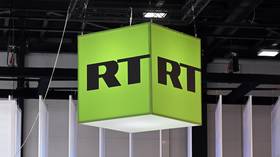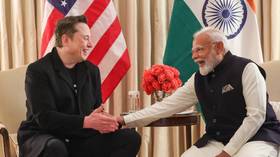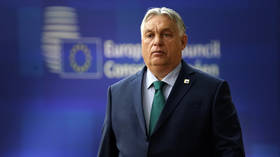As Iran is pushed to step further away from nuclear deal, what’s next?
Pushing back against US sanctions and European inaction on trade, Iran is stepping up its uranium enrichment. How far will Tehran go to apply pressure on the West, and how will the Europeans respond?
The 2015 Joint Comprehensive Plan of Action (JCPOA, or Iran Deal) set a uranium enrichment cap of 3.67 percent. Tehran sailed past the cap on Monday, with a spokesman for the country’s nuclear agency announcing it had reached 4.5 percent, and would consider upping enrichment to 20 percent. The International Atomic Energy Agency's inspectors confirmed the news later on Monday.
In addition, the Islamic Republic broke its 300kg low-enriched uranium stockpile limit less than a week ago.
While easily reversed, Iran maintains that these steps are “remedial,” and permitted by the 2015 agreement. Tehran wants the European parties to the deal to honor their trade commitments with Iran and deal in Iranian oil – a violation of American sanctions.
Also on rt.com ‘Unilateral bullying is worsening tumor’: China blames US pressure for Iranian nuclear crisisWhat can Iran do with 20 percent enriched uranium?
An enrichment level of 4.5 percent “completely satisfies the power plant fuel requirements of the country,” nuclear agency spokesman Behrouz Kamalvandi said on Monday. Previously, Iran’s only nuclear power plant at Bushehr was running on imported Russian fuel, enriched to a level of five percent.
A 20 percent enrichment level is still a considerable step below the 90 percent needed to make a nuclear weapon, but progression to weapons-grade uranium is not linear, Middle East expert Paul Heroux told RT. Once 20 percent is reached, he said, “you’re already mostly there.”
However, no country sets out to make just one nuclear weapon, former head of verification and security policy at the International Atomic Energy Agency (IAEA) Tariq Rauf told RT. Producing more than one weapon would entail putting old centrifuges back into action, and could take several years. For the moment, Iran is simply “sending signals that it can up the ante,” Rauf said.
Iran currently operates around 5,000 “primitive” centrifuges, Rauf explained. Before the JCOPA came into effect, that number was closer to 20,000. Restarting these centrifuges, Kamalvandi said on Monday, could be Iran’s next step.
European response
The United States has pounded Iran’s economy with sanctions since unilaterally withdrawing from the JCPOA last year, and Secretary of State Mike Pompeo responded to the latest enrichment increase with promises of “further isolation and sanctions.” European leaders have been more hesitant. Britain and Germany both warned Iran to halt its steps away from the deal, while French President Emmanuel Macron contacted Tehran to “resume dialogue,” but threatened non-specific “consequences” if enrichment continues.
Iran’s latest expansion of its nuclear program will lead to further isolation and sanctions. Nations should restore the longstanding standard of no enrichment for Iran’s nuclear program. Iran’s regime, armed with nuclear weapons, would pose an even greater danger to the world.
— Secretary Pompeo (@SecPompeo) July 7, 2019
“They’re probably not going to” sanction Iran, Heroux told RT. “I think the EU recognizes that Iran is not the problem right now, that it’s actually Donald Trump and his administration. We had a working deal and Donald Trump basically eviscerated it.”
Instead of more closely aligning with Washington, Heroux sees Europe continuing to “play a third party,” not completely siding with either Washington or Tehran.
European leaders should “put more pressure on the US to make a deal,” Udo Steinbach, former director of the German Institute for Middle East Studies, said. “The longer this is playing out, the longer we have the US sanctions and the Iranian threats to escalate, the more the EU is moving to the United States’ position,” he added.
Will Iran go all the way?
“It’s probable,” Heroux said. Given the recent military tensions between Iran and the US, coupled with the Trump administration’s relentless application of sanctions, Iran need only look east to see the benefits of acquiring the bomb.
Also on rt.com Carrot & stick: Macron teases ‘dialogue’ with Iran, threatens ‘consequences’ of nuclear deal breach“Based on the way Donald Trump has interacted with North Korea, and the way he has given them a lot more respect, it gives Iran an incentive to pursue nuclear weapons,” he said. “Once you join the nuclear club, you’re treated more seriously.” According to most experts, including Heroux, Iran could in theory have a nuclear weapon within a year.
Daniel McAdams of the Ron Paul Institute for Peace and Prosperity sees things differently. Rather than racing for the bomb, he sees Iran’s steps towards further enrichment and stockpiling as a calculated move to get the Europeans back to the negotiating table. Foreign Ministry spokesman Abbas Mousavi told reporters on Monday that Iran will give Europe 60 days to salvage the JCPOA through negotiations, and will offer no further deadlines.
“They are going about this in a very incremental, very methodical way,” McAdams told RT. “These are not the acts of a madman.”
Think your friends would be interested? Share this story!














